Whether it’s about Windows performance or security, a common advice by tech experts is to ensure Windows is up-to-date. And rightly so, Windows updates are crucial to ensure you’re protected from the latest vulnerabilities and fix any bugs to ensure an optimum experience.
Although, Windows update settings are configured by default to ensure you get the latest updates as soon as possible without interfering with your work. However, going along with the default settings isn’t always a good idea, especially when Windows updates can negatively impact your PC, like the infamous KB5012170 update.
Besides, there are a few Windows update settings that can negatively impact your PC without you even knowing. You should take control of how Windows should keep your PC updated, and I am here to help you with that. Today I will tell you everything you need to know to manage Windows updates.
Scope of Windows Updates

To help you understand the importance of Windows updates, you should know what it is responsible for keeping up-to-date. Many people think that the Windows updater’s job is to patch vulnerabilities/bugs and introduce new features. It’s actually much more than that, and below, I am listing some common duties of Windows updates:
- Patches to protect against known vulnerabilities. Usually known as Patch Tuesday, that happens on Tuesday of the 2nd week of each month.
- Major feature updates in the form of service packs, cumulative updates, etc., to improve overall performance, stability, and compatibility and add new features.
- Search and download the latest drivers for hardware (including newly added hardware). However, this job is arguably done better by a dedicated driver updater.
- It’s also responsible for updating Microsoft .NET Framework, which is a software development platform used by many apps on Windows.
- It also helps to deliver updates to Microsoft Edge.
- Updates Windows Defender’s latest virus definitions and detection capabilities.
- It can also be configured to update other Microsoft products like the Office suite or Visual Studio.
- When required, language packs are also downloaded by it.
It goes without saying that Windows updates are also responsible for Windows version upgrades, like upgrading from Windows 10 to Windows 11. Although users with unsupported PCs may have to use unconventional ways to upgrade, don’t involve the Windows updater.
Customize Windows Update Settings
There are a bunch of options related to Windows updates that decide how your PC will be updated. It’s important to configure them as many of these options can directly impact your work by restarting your PC unexpectedly or downloading data in the background.
To access these options, go to Windows Settings > Windows Update > Advanced options. You’ll see all the options to configure listed here.

Below is a quick explanation of each option and how you should customize them:
Receive updates for other Microsoft products
Enabling this will let Windows download updates for Microsoft’s standalone apps too. This includes apps like Office, Silverlight, Windows Subsystem for Linux, etc. Unfortunately, there is no official list telling exactly what apps this feature covers. I personally keep this enabled as I believe an up-to-date system is always better.
Get me up to date
When enabled, the Windows updater will try to restart and install the update as soon as it’s downloaded. Although it will give a notification 15 minutes prior to updating the PC. I will recommend you keep this disabled since it will interfere with your work either by nagging you with notifications or updating the PC while you are not there to delay the notification.
Download updates over metered connection
Metered connection basically means an internet connection with limited data, i.e., mobile data. When connected to a network marked as metered, Windows will avoid downloading updates to save data. However, it will still download critical updates.
Connecting to mobile data automatically marks the connection as metered. You can also manually mark a connection as metered by going to Settings > Network & internet > WiFi/Ethernet and enabling the option there.
If you have a limited data plan, then I’ll recommend you enable this option and mark the specific connection as metered.
A simple option to give a notification that an update has been downloaded and a restart is required. Definitely keep this enabled to know exactly when you need to update.
Active hours
Make sure you set up this option to let Windows know your working hours so it doesn’t update during those times and cause frustration. For me, the automatic option works fine as it chooses the time during which I usually sleep. You can manually select time here too, to ensure it doesn’t affect your work.

Optional updates
Here can you find updates that aren’t very important, and your PC will work fine even without them. However, it’s still worth checking out as you might find something that might enhance your experience. Most of the updates here will be related to drivers and standalone apps.

I actually found a better driver for my graphics card here once, I will definitely recommend checking it out.
Delivery Optimization
Using peer-to-peer (P2P) networking, Microsoft distributes its updates to lower load on its own servers. When enabled, it uploads or shares a part of an update already downloaded on your PC with the PCs on your network or other PCs on the internet that are also downloading it. Of course, this means it uses your connection bandwidth to upload the data to other PCs.
If you don’t need to worry about your connection bandwidth, then you can help out Microsoft by enabling it and letting it upload data to other PCs on the internet. Otherwise, at least select Devices on my local network option since it will let other PCs on your network update, too without using your bandwidth since they are on the same network.

If you are concerned about privacy/security, then Microsoft ensures it doesn’t make any connection with your files and data to make you vulnerable.
Installing Windows Updates
Installing Windows Updates is pretty straightforward. Depending on your settings, it will happen automatically. Windows doesn’t provide any easy way to prevent Windows updates from updating your PC. It’s just a matter of when and how it will be updated.
Once every day, Windows will check online if there is a new update available. If found, it will automatically download it and install it. The only limitation will be the metered connection setting that might prevent some types of updates from downloading.
Once downloaded, most of the updates are automatically installed, and you don’t need to do anything. However, some updates like Patch Tuesday and major updates require the PC to restart. The PC automatically restarts based on your configured settings to install these updates. It will install them even if the PC is manually restarted.

All the installed updates can be viewed in the Update History section. It lists all big and small updates here, and you can click the Learn More link next to them to learn exactly what was introduced in that specific update.
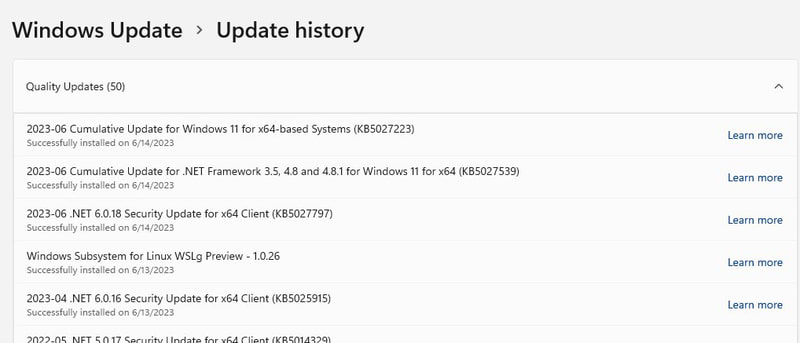
You can also manually check for updates by clicking on the Check for updates button. In case an update came after the automatic check, then the manual check will immediately download and install it.

Manually Download and Install Windows Updates
There can be many reasons why you may be interested in manually downloading Windows updates instead of using the Windows updater. For example, if you want to update PCs offline using a USB or you have Windows updates disabled (more on it later) for security purposes.
Thankfully, Microsoft Update Catalog is a website managed by Microsoft that lists all the updates released for Microsoft products, mainly Windows. In the search field, you can enter the KB number or keyword for the update you want to download to find and download that update.

The downloaded file will either have a .exe or .msu extension. You can just open it to install it on your PC. Some updates will still require a PC restart, though.
Tip: If you don’t know the exact name of the update you want to download. Search “Update history” on the Microsoft website, and you’ll see pages dedicated to storing the update history of different versions of Windows. There you’ll see updates listed with explanations.
Uninstalling Windows Updates
You can also uninstall specific updates in Windows if they are causing problems for you. To do so, open Control Panel using search and then go to Programs > View installed updates.

Here you’ll see all the installed updates along with the exact date when it was installed. Just double-click on an update and confirm the prompt to delete it.

I’ll recommend you take note of the update’s name or KB number to ensure you can manually install it later if needed. Also, not all updates can be uninstalled; some updates Microsoft doesn’t allow you to delete.
Delete Windows Updates Cache
While we are talking about getting rid of Windows updates, you might be interested in getting rid of updates that are already installed, but their installation files are still on your PC.
Windows keeps installation files of updates even after installing them, so you can roll back later in case of problems. These files can easily take away GBs of space without you even knowing.
There are many ways to delete this data, but using the Disk Cleanup utility will be the easiest. Just search for “disk cleanup” in Windows search and open the utility.
Here click on the Clean up system files button and select the drive where Windows is installed.
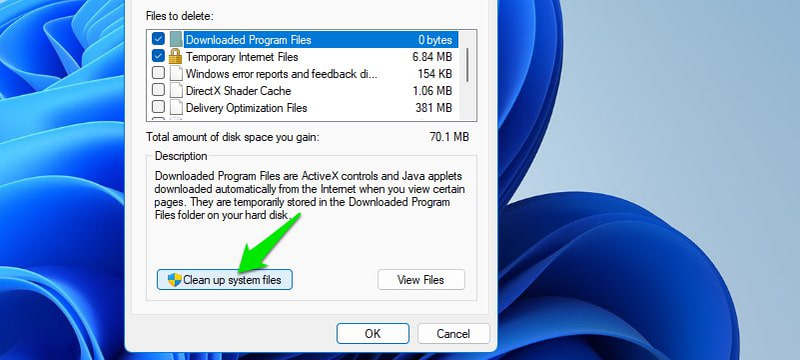
Now check the checkbox next to the Windows Update Cleanup option and click on OK to clean all this data.
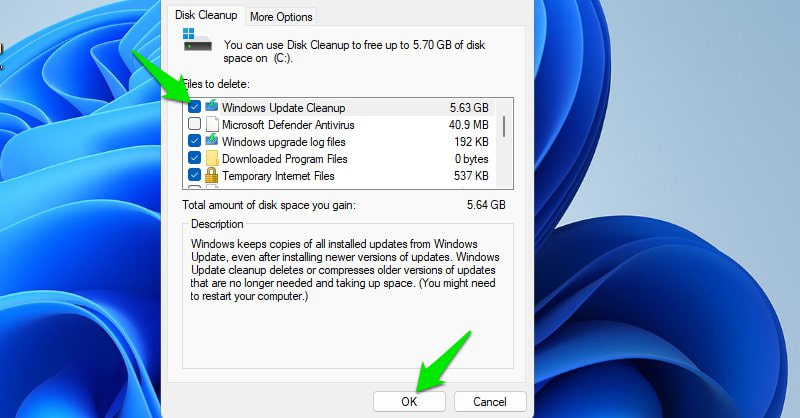
I will recommend you only do this if you are low on storage, and you won’t have to roll back to a previous update. Having these files is handy if you ever have to reset or restore your PC for whatever reason.
Pause or Disable Windows Updates
If you don’t want to risk installing a faulty update or don’t want to update Windows at all, then you can pause or disable Windows updates. I recommend pausing them if you are worried about faulty updates since Microsoft quickly repatches them or rolls them back.
Pause Windows Updates
You can pause updates for up to 5 weeks, and you can only select the time period in weeks starting from 1. In the same Windows Update options, click on the drop-down menu next Pause updates option and select the time period.
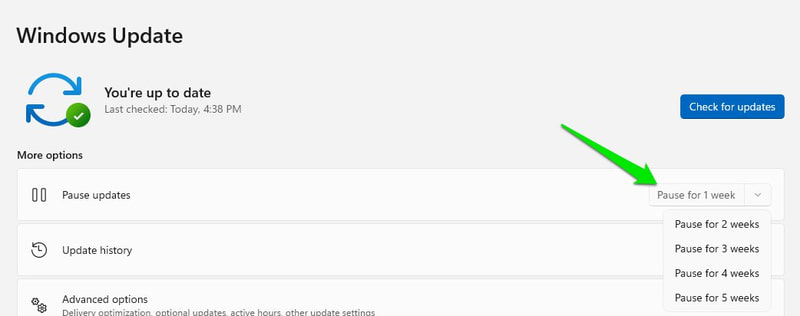
As soon as you select, the updates will be paused, and you’ll see a Resume updates button instead.
Disable Windows Updates
I will not recommend you do this since it will make your PC vulnerable. However, it is possible to disable Windows if you must do it like you prefer installing updates manually.
To do so, press the Windows+R keys to open the Run dialog and enter services.msc in it to open Windows Services.
Now scroll down to the Windows Update service. Right-click on it and select the Properties option.
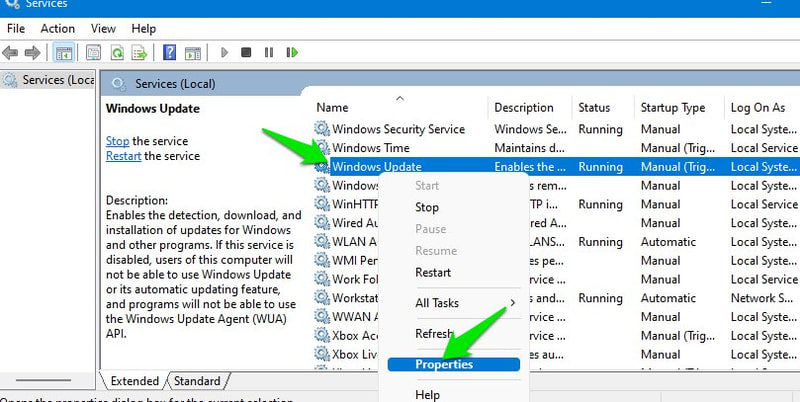
Here first click Stop under the Service status section and then select Disabled in the Startup type section.

Once you apply these changes, Windows will not automatically update. However, you can still manually update by clicking on the Check for updates option.
Use Third-Party App to Disable Windows Updates
You can also use a third-party app to disable Windows updates if you find that easier. Windows Update Blocker is great for this purpose, as it’s really easy to use and gets the job done.
You only need to select Enable Updates or Disable Updates option in its interface to quickly enable/disable the Windows updates feature.

Troubleshoot Windows Updates
There is a possibility a Windows update might negatively impact your PC. Furthermore, the Windows Updater might also face issues that could prevent it from downloading specific updates or installing them. If you face such issues, there are a few things you can do to fix the issues.
Use Windows Update Troubleshooter
Windows has a bunch of troubleshooters to automatically fix common Windows problems. If you are having trouble with the Windows Updater, then you can use Windows Update Troubleshooter to possibly fix it.
To use it, open Settings and go to System > Troubleshooter > Other troubleshooter. Here click on Run next to Windows Update, and a wizard will open to guide and automatically solve problems. Some solutions might require you to restart the PC.

Alternatively, you can also use a third-party repair tool that can automatically fix updates-related issues if the built-in troubleshooter doesn’t work.
Use System Restore
In case a new update has negatively impacted your PC, you can roll back to a previous version of Windows that won’t have that update installed. The system Restore option lets you roll back to a previous version, and it’s enabled by default on Windows.
Press the Windows+R key and type rstrui in the Run dialog to open the System Restore wizard. Here it will recommend a restore point and the time it was created. Choose it if it’s before the problematic update. Otherwise, select Choose a different restore point option to see available restore points.

Just select the restore point that is before the problematic update, and Windows will restore your PC to the state when that update wasn’t there.
It’s worth mentioning, that uninstalling the update (as shown above) is also an option to possibly fix it. However, not all updates can be uninstalled, so System Restore is a better option in that case.
Ending Words 👨💻
What I personally like to do is tell Windows to only update my PC during inactive hours. However, I manually update it whenever I find some free time during my work. It just takes a restart, after all, and I stay up-to-date as soon as possible.
Although for people with very sensitive data on a PC or working in a corporate environment, a faulty update can be a big issue. In that case, delaying or manually updating can be a good option.
You may also read about How to install Windows 11 on an unsupported PC.
Si quiere puede hacernos una donación por el trabajo que hacemos, lo apreciaremos mucho.
Direcciones de Billetera:
- BTC: 14xsuQRtT3Abek4zgDWZxJXs9VRdwxyPUS
- USDT: TQmV9FyrcpeaZMro3M1yeEHnNjv7xKZDNe
- BNB: 0x2fdb9034507b6d505d351a6f59d877040d0edb0f
- DOGE: D5SZesmFQGYVkE5trYYLF8hNPBgXgYcmrx
También puede seguirnos en nuestras Redes sociales para mantenerse al tanto de los últimos post de la web:
- Telegram
Disclaimer: En Cryptoshitcompra.com no nos hacemos responsables de ninguna inversión de ningún visitante, nosotros simplemente damos información sobre Tokens, juegos NFT y criptomonedas, no recomendamos inversiones

